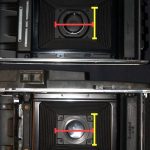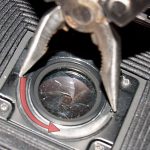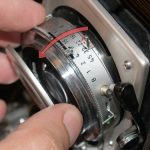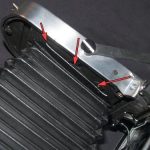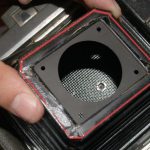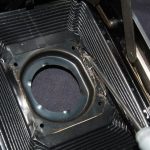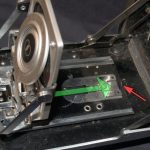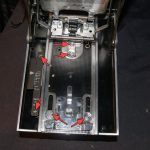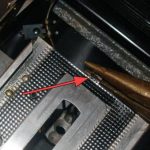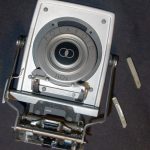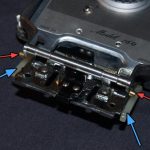Because the bellows of my 110A were so dirty, and the 160 so clean, I figured I should keep the 160 and simply swap the plate which touches the lensboard.
If you have the opposite, where the 110A bellows are worth saving, you can unclip the bellows from the camera body by prying up the tabs of the metal mask along the 4 edges.
The 160 and the 110A bellows plate is the same size, but not the same shape.
The 160 must be removed, and the 110A put in its place.
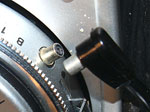 The lens is held to the board with a retaining ring. The ring itself should have 2 to 4 notches.
The lens is held to the board with a retaining ring. The ring itself should have 2 to 4 notches.
Using some pliers, carefully, turn the ring but DO NOT remove it all the way.
Open the front of the camera. Disconnect the flash cord.
Now the lens is held in place by the lens cap and retaining ring.
If the bellows did not detach from the 160 and/or 110A lensboards when you removed the 4 screws, pry a little along the edges, should come right off.
Since the 110A is being trashed, I didn’t care about the bellows condition as I removed it.
When removing the plate from the bellows you are keeping, carefully pry not just the black outer covering, but the inner glued down backing.
Do one side at a time and go slowly.
Remove the 110A lensboard by first snipping the flash cord then bending the stop tab in back, red arrow, and pulling it back while the focus rails are all the way out.
Since I am going to releather the body it is best to remove all the focus rail parts.
This will make it easier to remove the 160 lensboard and peel off the leather.
Remove all 6 screws from the 160.
Be careful about the washers contained under the larger 2 front screws and the 2 semi circle plastic washers underneath the 2 smaller screws in the back.
Remember, this is a Japanese camera…the screws are METRIC unlike the 110A or other American made models.
You can not swap screws, so save them!
Bend the stop tab down and you can now easily remove the 160 lensboard.
If you want to use the 110A rails instead, you’ll need to undo the clip holding it to the rangefinder coupling.
If your lensboard assembly did not track smoothly along the focus rails, these plastic pieces you see are to blame.
The 110A had one crooked and certainly in rough shape.
The spring arms of the assembly also had 2 small plastic tips which held them into the focus rail tracks. They too were worn.
Luckily, the 160’s assembly parts are a good exchange if yours are worn as well.
Working backwards, attach the 110A bellows plate to the 160 bellows, Super Glue works great.
Replace the 110A lensboard assembly to the 160 by sliding it into the rails and bending the stop back up.
Attach the 4 screws to the lensboard from behind the bellows.
